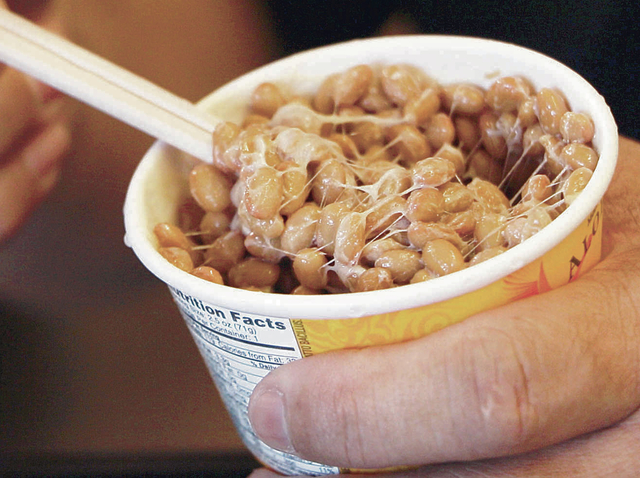Natto is one of those foods people either love or hate.
There’s something about the slimy texture and smell of fermented soybeans that excites natto lovers and causes haters to gag.
“The taste is not bad once you get past the smell and the slime,” said Paul Uyehara, president of Aloha Tofu, whose family company has been making natto since the 1970s.
Uyehara describes the smell of natto as similar to “old socks that’s been sitting for a month.”
The taste, he said, “is kind of an earthy, beany flavor. I think earthy is the best way to describe it. It’s not like eating dirt. It’s kind of a rustic flavor.”
Aloha Tofu sells about 750 pounds of natto a month.
To make it, soybeans are soaked overnight and then steamed in a pressure cooker.
The bacteria that starts the fermentation is mixed with water and poured over the cooked beans using a green plastic watering can. Then the beans are left in a steam room overnight before being packed.
“The natto is ready to eat when it’s fresh, but it’s not as good,” Uyehara said. “What I tell people is that the next day, right after the natto is done, you don’t want to eat it because it won’t have its fully developed flavor.”
Wait at least a week, he said, “and then you can have a deeper, a richer, a more aromatic experience with natto.”
Uyehara admits he didn’t like natto growing up and had to learn to appreciate it.
His wife, who does like natto, told him that if he sold the product, he should eat it, too.
She made him natto spaghetti, cooking the natto, which removed the sliminess and smell. Uyehara said he worked his way from that to eating his natto raw.
It’s traditional to eat natto with hot rice. Elements such as seaweed, wasabi and fish can be added to give texture, saltiness, spice and other flavors.
Uyehara opens a container and points to white, moldlike specks on the beans.
“This is what you want,” he said. “It means it’s ready.”
He stirs with chopsticks, and the mixture gets gooey and whitish lines of slime appear.
“The cobwebs and all these things, the stringy stuff between the beans, is what gives it its power,” Uyehara said. “You want as much stickiness and gooeyness as possible,” he said.
Uyehara adds soy sauce and green onions and spoons the mixture over rice.
I’ve enjoyed natto in sushi bars with ahi, wasabi and yamaimo, a Japanese yam that also gets slimy when you chop and stir it. But I’ve never really eaten it as a main ingredient.
I start with a sniff. It smells sour, like most fermented foods, not as strong as kim chee, but with a similar musty scent.
The taste is also sour initially; then you taste the beans, and the sour, fermented flavor fills your mouth and lingers.
The soy sauce and other ingredients that Uyehara provides, like kim chee and konbu (seaweed), add texture and saltiness.
Fermentation — controlled spoilage, really — gives natto its sliminess and sour taste but also makes it good for you, Uyehara insists. The bacteria produced is similar to the probiotic bacteria in yogurt, kim chee and sauerkraut.
“It’s good for you, good for your digestion, good for your blood,” he said. “You eat this and you live longer.”
Web producer Craig Gima tries out new foods in a video and print series every other Wednesday. Dare him to try a really scary food: cgima@staradvertiser.com.




